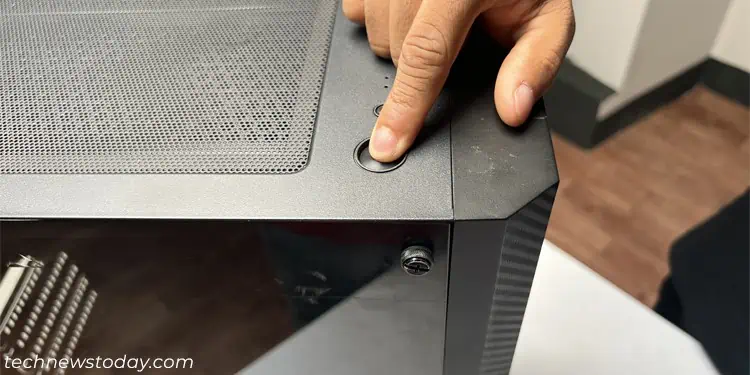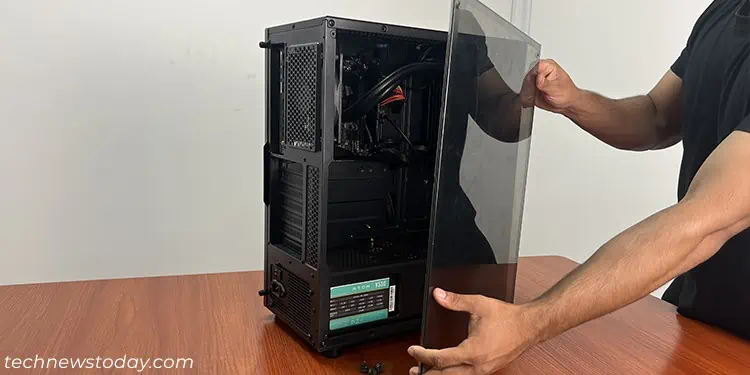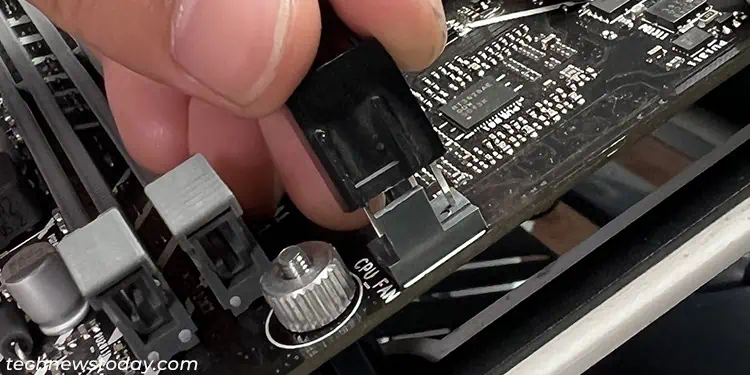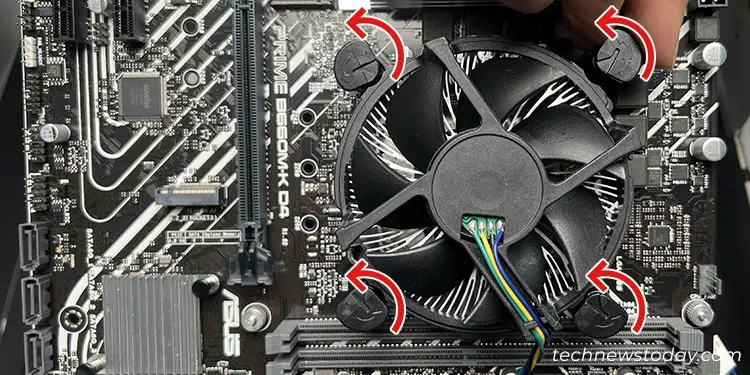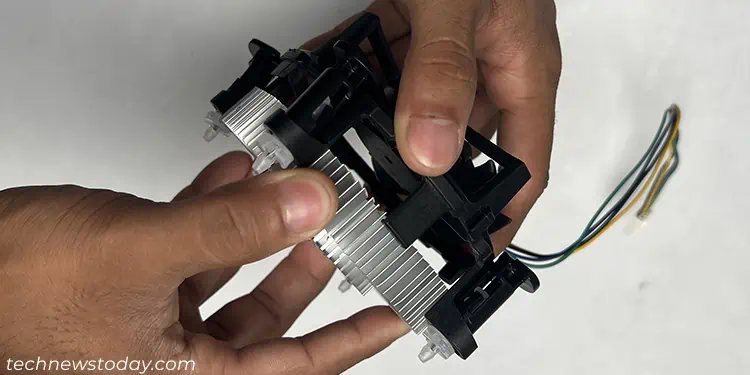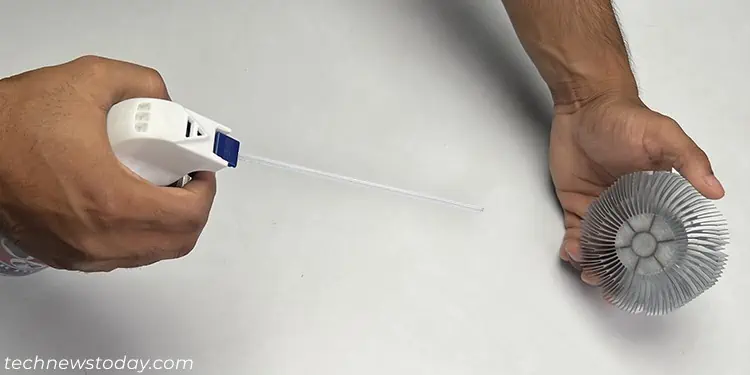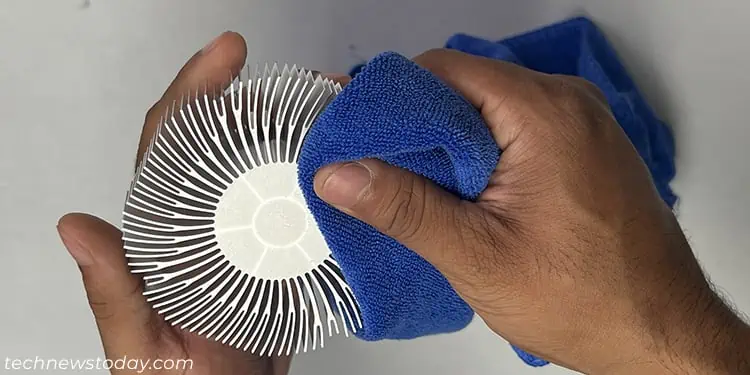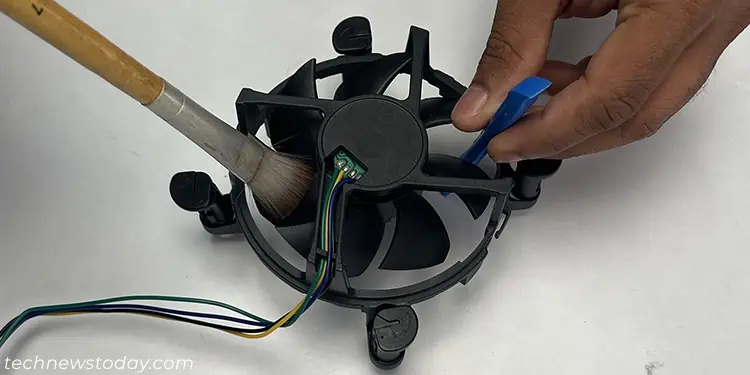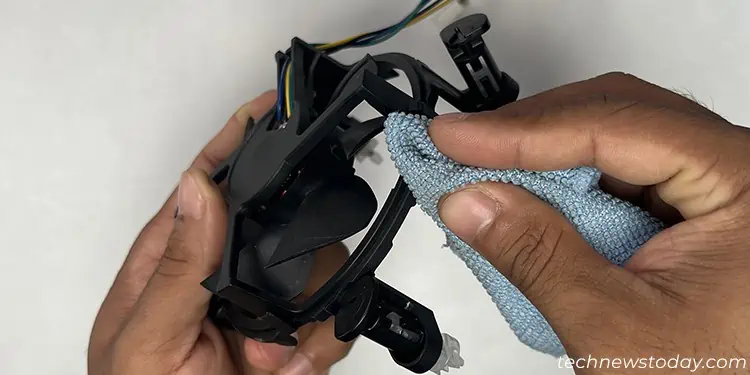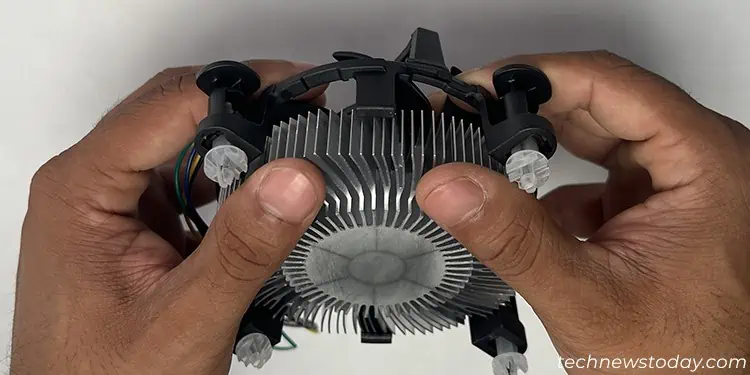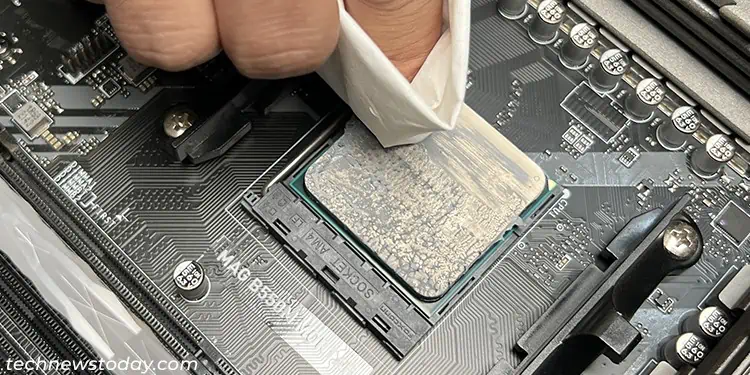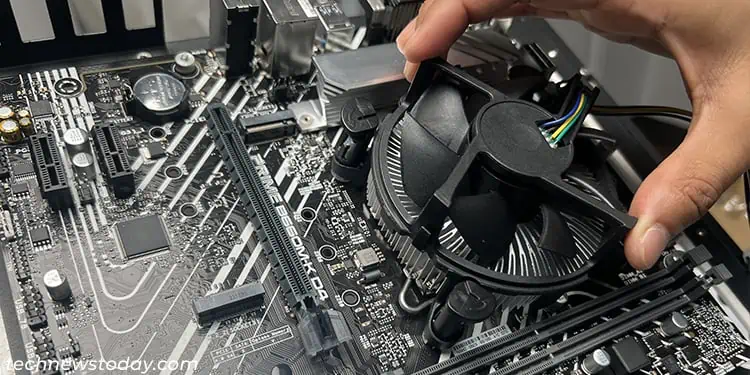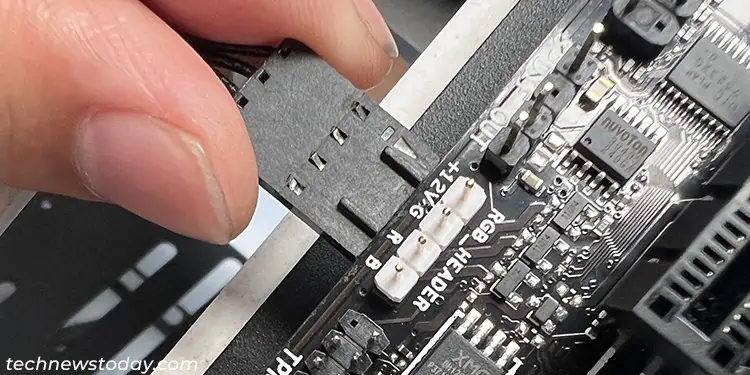Dust accumulated on the CPU cooler creates an insulation layer and affects the heat dissipation process. So, you need to clean your CPU cooler regularly to prevent any overheating issues.
I recommend cleaning your cooler at least once every 3-6 months if it’s an air cooler and every 6-12 months if it is a liquid cooler.
The best way to clean such coolers is by using a compressed air spray can. But you can also take them apart and clean the heatsink with water. For all other parts, use compressed air, or if you can’t, use a brush.
How to Clean Air Coolers
If the air cooler is not too dirty, you can use a compressed air can to blow the dust away from your PC as well as the cooler. However, if it has been a few months since you installed or last cleaned the cooler, it’s best to take it out and clean it thoroughly.
Expose the Cooler
The first thing you need to do is open your PC case to expose the cooler so that you can take it out.
- Shut down your PC. Remove all of the peripheral and power cables.
- Press the power button and hold it for a few seconds. This drains all the remaining charge inside.

- Take your case to a clean table. You don’t want your room to get dirty while cleaning the cooler.
- Remove the side panel. You usually need to unscrew and slide it out. Some PC cases may need different methods, so I recommend checking its user manual if you need additional help.

Remove the Cooler from the PC
Now, you can remove the air cooler outside your case. The way to remove your cooler depends on the mounting mechanism used while it’s installed.
- Disconnect the fan and RGB cables from the motherboard.

- Then you need to unlock the cooler from the motherboard.
- For the cooler with Retention Clip, pull the CAM lever to loosen the cooler. Then, unlock the retention clips from the brackets.

- For the cooler with Spring screws, unscrew the four screws starting from one diagonal until they all unlock.

- For the cooler with push pins, turn all the pins 90° in anticlockwise direction to unlock them.

- Other coolers generally have mounting brackets, so you need to unscrew them.
- For the cooler with Retention Clip, pull the CAM lever to loosen the cooler. Then, unlock the retention clips from the brackets.
- Pull out the cooler gently. You can twist in both directions and pull gently if it sticks to the CPU.

If other components like RAM or GPU are obstructing you from unlocking the cooler or getting to the clips/screws, you need to remove them first.
Remove the Fans from the Heat Sink
It’s better to clean the cooler’s heatsink and fan separately to be able to access all areas of the component. Depending on whether it is a tower cooler (single-tower ‘D’-type, dual-tower ‘U’-type, top-flow tower ‘C’-type, or low-profile ‘L’-type) or a stock cooler, you need to perform different steps to separate these parts.
- For coolers with push pins or retention clips, the fan is usually attached to the heatsink using some clips.
- Hold the cooler upside down.
- Push these clips outwards using a spudger while using your hand to push or pull up the heat sink.

- After the fan unlocks, pull it away from the heatsink to separate them.

- For coolers with spring screws, the fan is usually attached to the heatsink using separate screws.
- The cooler usually contains a cap or cover. You need to turn the cooler upside down and look for clips or locks on the cover. Then, pull the cover outwards on the areas with the clips to unlock and remove it.

- Unscrew the fan from the heat sink and separate them.

- The cooler usually contains a cap or cover. You need to turn the cooler upside down and look for clips or locks on the cover. Then, pull the cover outwards on the areas with the clips to unlock and remove it.
- U, D, C or L-Type air coolers use detachable case fans, which are connected to the heat sink through some clips or screws. You can similarly unlock and separate them.
Clean the Heat Sink
It’s best to clean the heatsink before anything else. Since it does not contain any electronic parts, you can clean it with water. But if you don’t want to leave it to dry for 1-2 days, it’s best to use compressed air to blow out all the dust particles.
- Use isopropyl alcohol and microfiber or any lint-free cloth to clean the thermal paste and any other stuck gunk from the heat sink.

- Then use compressed air or a brush to clean the fins on the heat sink. Depending on the type of cooler, a brush may not reach all the gaps, so using a compressed air spray can is the better option.

- You can wash it with a pressure hose if it is too dirty. This method is especially useful if the thermal paste gets inside the fins and doesn’t get out easily.
If the pressurized water source is not available, use any running water with a brush or toothbrush to get inside the fins.
- If you are using water to clean the fins, make sure to wipe the heat sink and leave it to dry in a cool place until all the water evaporates. It will usually take a day or two until it is completely dry.

Don’t use a hairdryer or lay it under the sun, as it can cause oxidation on the outer layer of the heat sink and decrease its thermal conductivity.
If your CPU cooler is a retention-clip type cooler, make sure to clean the clip as well. You can use a microfiber cloth to do so.
Clean the Fan and PC
Now, you need to clean the cooler’s fan. Also, clean your PC case and other internal components before reinstalling your cooler, as the dust from these components can once again get inside the cooler.
- It’s better to use a compressed air spray or a soft-bristle brush to clean the fan blades. It’s better to hold the fan blades using a spudger or something similar while cleaning so that you don’t damage the motor bearings inside.

- You can similarly use the same tools or even a microfiber or lint-free cloth to clean the other parts of the fan or cooler.

- If there are any hard-to-reach spots with dust or gunk, use a Q-tip to reach and clean them. You shouldn’t use any cleaning solvent like isopropyl alcohol as they may damage the plastic surface.
- You should also clean your PC so that all the internal components, the PC case, other computer fans and the power supply unit are dust-free.
Assemble the Air Cooler and PC
After cleaning the fan and the heatsink, you need to reconnect them and reinstall the assembled cooler on the PC.
- After making sure that the heat sink is dry, reconnect it to the fan along with any additional covers/clips. You need to screw or clip them together depending on the locking mechanism.

- Clean off any thermal paste from the CPU. Ensure the paste doesn’t reach the motherboard or CPU socket.

- Reapply a proper amount of thermal paste to the CPU using a suitable pattern.

- Reinstall the cooler on the PC by reversing the steps for their removal.

- Connect the fan cable to the motherboard’s CPU_FAN header and any RGB cables to the +12V RGB header.

- You need to reinstall any components you had removed to gain easier access to the cooler, like the RAM or the graphics card.
- Attach the side panel to the PC the same way you removed it.
How to Clean Liquid Coolers
Liquid coolers come in two forms— AIO coolers and custom loops. It’s recommended to clean both these coolers once or twice every year.
AIO coolers come as fully manufactured units and it’s not recommended to open them and clean the insides without specialized tools.
The only thing you can do is clean the radiator and fans. You can use compressed air or a pressurized water hose to clean the radiator. To clean the fans, use compressed air or a brush instead.
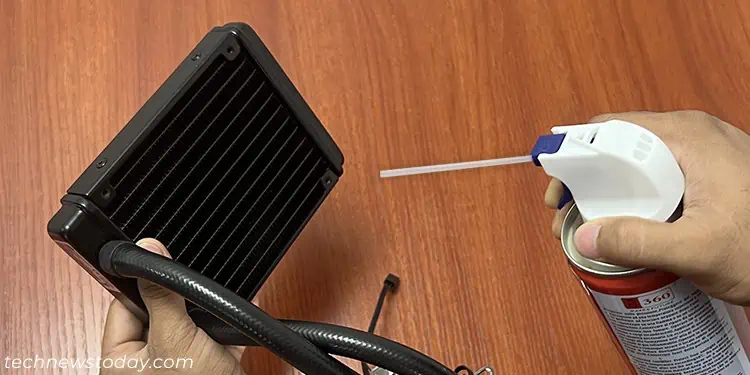
For custom loops, it is possible to separate their individual parts and clean them completely. The process depends on your setup, but generally, you need to perform the following steps:
- Drain the coolant from the loop through the valve.
- Fill the loop with water or specialized cleaning solution for liquid coolers and run it for an hour or more, depending on how dirty the coolant is.
- You need to use the custom guide for such cleaning solutions if you use any.
- You should not try creating your own cleaning solution, as you may not be able to get it out completely while rinsing the loop.
- Drain the water or cleaning solution.
- Rinse the loop with distilled water 3-4 times in the same way and drain it. It’s better to make sure that the pH level of the liquid after the final rinse is 7.
- You can also separately clean the inside of the radiator before cleaning the whole loop since it is the component that gathers most dirt or gunk.
- If your radiator has gathered some dust on the outside, you can clean it the same way you would for an AIO (using compressed air or pressurized water hose).
- Then, check the loop for any leaks and refill a corrosion-inhibiting coolant before setting it up.
You can also clean the metal surface and the tops on the water block before flushing the loop.
- If you have pure copper water blocks, you can clean the metal surface using vinegar to clean the copper surface.
- For nickel-plated copper water blocks, you shouldn’t use any such abrasive cleaning agents to clean the metal surface. Simply use warm water and a cloth.
- You also can’t use any such cleaners for the tops.
- Use soapy warm water and a toothbrush to clean Plexi (Acrylic Glass) tops.
- Acetal (POM) tops can resist alcohol or acetone, so you could use cleaners with these chemicals. But I recommend simply using soapy and warm water with a toothbrush for these as well.

